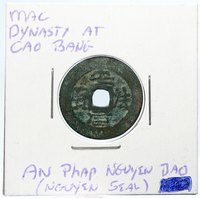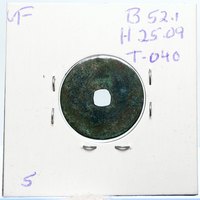|
Vietnam - Mac Dynasty at Cao Bang (1592-1677)
Bronze An Phap Nguyen Bao Cash Token 22mm, Struck 1592-1677
Reference: B 52.1, H 25.09 Toda 040
Chinese Symbols.
Nyugen seal.
You are bidding on the exact item pictured, provided with a Certificate of Authenticity and Lifetime Guarantee of Authenticity.
 Cao Bằng is a city in northern Vietnam. It is the capital and largest settlement of Cao Bằng Province. It is located on the bank of the Bằng Giang river, and is around 30 kilometres (19 mi) away from the border with China's Guangxi region. According to the 2019 census, Cao Bằng City has a population of 73,549 people. Cao Bằng is a city in northern Vietnam. It is the capital and largest settlement of Cao Bằng Province. It is located on the bank of the Bằng Giang river, and is around 30 kilometres (19 mi) away from the border with China's Guangxi region. According to the 2019 census, Cao Bằng City has a population of 73,549 people.
 The area, Cao Bằng (高平; 'high plateau'), was the stronghold of the last years of the Mạc dynasty after their 1592 defeat at the hands of the Trịnh lords. During the 19th century the area was resistant to the Nguyễn government. The area, Cao Bằng (高平; 'high plateau'), was the stronghold of the last years of the Mạc dynasty after their 1592 defeat at the hands of the Trịnh lords. During the 19th century the area was resistant to the Nguyễn government.
The city is also known for the Battle of Cao Bằng, the first major decisive victory of the Việt Minh against the French Army.
 The Mạc dynasty (Vietnamese: Nhà Mạc / Mạc triều / Nhà Bắc Mạc; Hán Nôm: 家莫 / 莫朝 / 家北莫), as known as Northern Mạc or House of Mạc ruled the whole of Đại Việt between 1527 and 1540 and the northern part of the country from 1540 until 1592, when they lost control over the capital Đông Kinh for the last time in their wars against the Lê dynasty. Subsequent members of the Mạc dynasty ruled over the province of Cao Bằng (with the direct support of the Ming and Qing dynasties) until 1677. The Mạc dynasty (Vietnamese: Nhà Mạc / Mạc triều / Nhà Bắc Mạc; Hán Nôm: 家莫 / 莫朝 / 家北莫), as known as Northern Mạc or House of Mạc ruled the whole of Đại Việt between 1527 and 1540 and the northern part of the country from 1540 until 1592, when they lost control over the capital Đông Kinh for the last time in their wars against the Lê dynasty. Subsequent members of the Mạc dynasty ruled over the province of Cao Bằng (with the direct support of the Ming and Qing dynasties) until 1677.
The revolt of the Revival Lê in the south gathered strength and over the next three years all the provinces south of the Red River were captured by the Lê armies. In 1533 the figurehead Lê Emperor, Lê Trang Tông, was officially crowned at the recaptured Tây Đô castle. This marked the beginning of the Southern and Northern dynasties era. The Lê and Mạc would continue the lengthy civil war over the next 40 years.
In 1540, Mạc Đăng Doanh died and Mạc Đăng Dung reclaimed the throne. The Ming dynasty threatened Mạc Đăng Dung with an invasion of 110,000 men ready to invade Vietnam from Guangxi. Mac caved in to Chinese pressure and accepted their bitter demands, including crawling barefoot in front of the Chinese officials, giving up land to China, downgrading his status from the Emperor to Governor (Đô thống sứ 都統使) and giving up official documents like tax registers to the Ming. The Ming official position was that the Mạc should rule over the northern half of Vietnam, while the Lê should rule over the southern half (in other words, below the Red River). The Nguyễn and the Trịnh refused to accept this division of the country and the war continued.
In 1541, Mạc Đăng Dung died and was succeeded by his grandson Mạc Phúc Hải.
Mạc Phúc Hải ruled only for six years, during which he was defeated by the Trịnh army and lost more territories. He was succeeded by Mạc Phúc Nguyên (1545–61) who had to fight a war with his brother Trung.
Mạc Mậu Hợp ruled from 1561 to 1592. He was the last significant Mạc ruler. In 1572 the capital was captured by the Trịnh army but then he recaptured it a year later. Then, in 1592, Trịnh Tùng unleashed a massive invasion of the north and conquered Hanoi along with the rest of the northern provinces. Mạc Mậu Hợp was captured during the retreat and was cut to pieces over three days. The Mạc had lost control over most of Vietnam, only retaining areas around Cao Bằng Province under the formal protection of the Ming army.
In 1592, the new Mạc leader was Mạc Kinh Chi. He managed to assemble a large army which defeated the army of Trịnh Tùng but a year later, he and his army were wiped out by a new Trịnh army under Trịnh Tùng. Mạc Kinh Cung ruled for more than twenty years (1593–1616). Based out of Van Ninh (Quảng Ninh Province) the Mạc army staged many attacks against the Trịnh. The Trịnh requested and received aid from the Nguyễn and the joint army (with Nguyễn Hoàng) defeated the Mạc.
In 1598, yet another official Ming commission declared the Mạc to be rulers over Cao Bằng province and so the Mạc rulers stayed in this protected area, occasionally launching raids into Trịnh controlled Vietnam.
In 1627, the Lê army attacked Cao Bằng, the Mạc ruler Mạc Kính Khoan had to surrender and accept the Lê title of Thông quốc công, reducing the Mạc realm to a Duchy under the Lê dynasty.
After the fall of the Southern Ming, the Qing dynasty became the mediator in the Lê-Mạc conflict while receiving tribute from both sides. The Kangxi Emperor attempted to negotiate peace between the two states. After the Lê attacked and gained control of Cao Bằng Province without permission from the Qing, the Kangxi Emperor demanded in 1667 that Lê Chiêu Thống return Cao Bằng Province to the Mạc. In 1673, the Qing had lost interest in mediating the conflict on behalf of the Mạc. In 1677, the Revolt of the Three Feudatories in southern China prompted the Qing to enlist the aid of the Lê, who accused the Mạc of joining the rebels. The Kangxi Emperor and his advisors agreed to arrest Mạc Kính Vũ as he fled into Guangxi, leading to the demise of the Mạc dynasty.
Cash was a type of coin of China and East Asia, used from the 4th century BC until the 20th century AD. Originally cast during the Warring States period, these coins continued to be used for the entirety of Imperial China as well as under Mongol, and Manchu rule. The last Chinese cash coins were cast in the first year of the Republic of China. Generally most cash coins were made from copper or bronze alloys, with iron, lead, and zinc coins occasionally used less often throughout Chinese history. Rare silver and gold cash coins were also produced. During most of their production, cash coins were cast but, during the late Qing dynasty, machine-struck cash coins began to be made. As the cash coins produced over Chinese history were similar, thousand year old cash coins produced during the Northern Song dynasty continued to circulate as valid currency well into the early twentieth century. In the modern era, these coins are considered to be Chinese "good luck coins"; they are hung on strings and round the necks of children, or over the beds of sick people. They hold a place in various superstitions, as well as Traditional Chinese medicine, and Feng shui. Currencies based on the Chinese cash coins include the Japanese mon, Korean mun, Ryukyuan mon, and Vietnamese văn.
| 

 Cao Bằng is a city in northern Vietnam. It is the capital and largest settlement of Cao Bằng Province. It is located on the bank of the Bằng Giang river, and is around 30 kilometres (19 mi) away from the border with China's Guangxi region. According to the 2019 census, Cao Bằng City has a population of 73,549 people.
Cao Bằng is a city in northern Vietnam. It is the capital and largest settlement of Cao Bằng Province. It is located on the bank of the Bằng Giang river, and is around 30 kilometres (19 mi) away from the border with China's Guangxi region. According to the 2019 census, Cao Bằng City has a population of 73,549 people. The area, Cao Bằng (高平; 'high plateau'), was the stronghold of the last years of the Mạc dynasty after their 1592 defeat at the hands of the Trịnh lords. During the 19th century the area was resistant to the Nguyễn government.
The area, Cao Bằng (高平; 'high plateau'), was the stronghold of the last years of the Mạc dynasty after their 1592 defeat at the hands of the Trịnh lords. During the 19th century the area was resistant to the Nguyễn government. The Mạc dynasty (Vietnamese: Nhà Mạc / Mạc triều / Nhà Bắc Mạc; Hán Nôm: 家莫 / 莫朝 / 家北莫), as known as Northern Mạc or House of Mạc ruled the whole of Đại Việt between 1527 and 1540 and the northern part of the country from 1540 until 1592, when they lost control over the capital Đông Kinh for the last time in their wars against the Lê dynasty. Subsequent members of the Mạc dynasty ruled over the province of Cao Bằng (with the direct support of the Ming and Qing dynasties) until 1677.
The Mạc dynasty (Vietnamese: Nhà Mạc / Mạc triều / Nhà Bắc Mạc; Hán Nôm: 家莫 / 莫朝 / 家北莫), as known as Northern Mạc or House of Mạc ruled the whole of Đại Việt between 1527 and 1540 and the northern part of the country from 1540 until 1592, when they lost control over the capital Đông Kinh for the last time in their wars against the Lê dynasty. Subsequent members of the Mạc dynasty ruled over the province of Cao Bằng (with the direct support of the Ming and Qing dynasties) until 1677.
